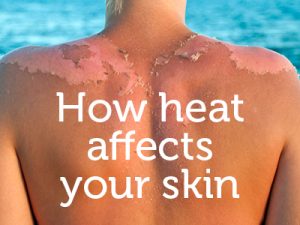27 Jul How Heat Affects Your Skin

The sun is shining and temperatures are soaring. After a long cold winter, it can be wonderful to feel the sun on your skin, however, the heat can make eczema and other dry skin conditions flare-up.
Everyone is different, and therefore our skin responds differently to environmental changes. Some people’s skin gets better in the summer months, while others notice that their skin can feel tight, itchy and extremely hot. There are a number of ways in which the warm weather can trigger skin dryness and exacerbations of eczema:
Some like it hot
If you’ve ever seen a leaf shrivelling up under the burning sun, you’ll understand that exposing something to heat can increase the loss of moisture. Your skin is no different. This heat can be from a direct source like a fire or electric heater, or it can be from the heat of the sun. Heat can also lead to the development of prickly heat type symptoms which can really exacerbate itching.
Sun safety
UV light is used as a treatment for eczema and some people find that sunlight soothes their skin, however UV exposure can also dehydrate the skin. Everyone needs to protect their skin from the harmful effects of the sun’s rays but sun creams can contain ingredients that sensitise your skin and trigger a flare-up. Take care and look at the labels for known irritants and fragrances. Many people with eczema find that a broad-spectrum mineral block is kinder to their skin than chemical formulations.
The sweat factor
Sweating is the body’s instinctive response to heat. As sweat evaporates it cools the body down, dropping the temperature and making us more comfortable. However, sweating can make the itch of eczema much worse.
Research suggests that people with eczema may be super-sensitive to substances in their own sweat, triggering an allergic reaction and itchy, irritated skin. The chronic scratching of eczema can also make the skin thicker, this results in increased sweat production, compounding the problem. Once sweating has triggered the itch, it can be a vicious cycle. You scratch, which damages the skin’s protective barrier causing more irritation, inflammation and itching. It’s the frustrating itch-scratch cycle that people with dry skin conditions are all too familiar with.
Dry environment
It’s not just heat that affects your skin, it’s the humidity too. A hot dry climate can make the skin more likely to flare up. Annoyingly there’s no escape by hiding away inside, because air conditioning can also dry out your skin.
How can I prevent itching and keep my skin healthy?
If this blog has made you want to hide away in a darkened room, don’t panic. There are lots of ways of keeping you cool and protecting your skin:
- Wear loose and breathable clothes that will help you stay comfortable and allow any sweat to evaporate.
- A quick, tepid shower will rinse off sweat and keep you cool. Avoid scented soaps and shower gels which can dry-out and irritate sensitive skin. Instead use AproDerm® Colloidal Oat Cream or AproDerm® Emollient Cream, which are emollient soap substitutes. They’ll clean your skin without dehydrating it.
- After showering, apply an emollient when the skin is still damp to lock in moisture and maintain skin hydration.
- Regularly use an emollient like AproDerm® to decrease dryness and itching and prevent flare-ups. They form a protective layer over the skin, trapping in water and moisturising the skin cells. An ointment is rich and greasy and can be great for moisturising at night but be careful in the day because it could make your skin fry! During the day applying a lotion, cream or hydrating gel can be light and cooling when the mercury is high. Why not store them in the fridge for even more relief?
- Stay in the shade when you can, especially during the heat of the day between 11am and 3pm.
- Protect your skin from the sun’s rays by wearing a t-shirt, a hat and sunglasses.
- Always use a high-factor sunscreen. Slather it on generously and reapply regularly. Do a patch test before use to check for any signs of sensitivity and remember to apply at least half an hour after your emollient, so that it isn’t diluted.



Sorry, the comment form is closed at this time.